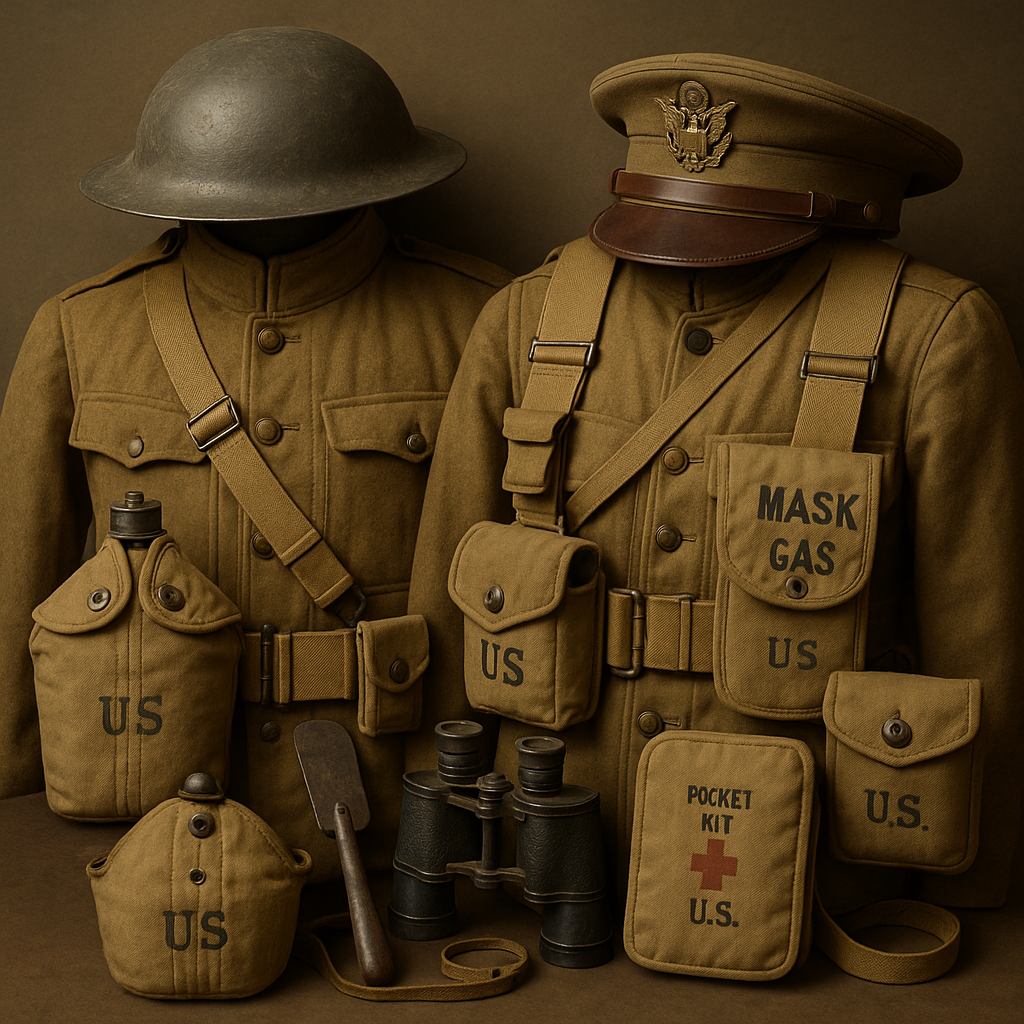
WWI Uniform Accessories: A Deep Dive into Military Gear from the Great War
Published on Jun 01, 2025
WWI Uniform Accessories: A Deep Dive into Military Gear from the Great War
The First World War wasn't just a landmark in global politics—it was also a turning point in military fashion and equipment. Among the most enduring elements of this conflict were the accessories worn by soldiers across Europe and beyond. At Paddelaters.com, we specialize in war-related uniforms and accessories, and today we're exploring the WWI uniform accessories that defined an era—and helped shape what would become the more familiar World War 2 medic uniform, OD green fatigues and army officer hats of WWII.
1. Introduction to WWI Military Accessories
When we think of WWI uniforms, iconic images of soldiers clad in wool tunics, puttees, and Brodie helmets often come to mind. However, what truly completed these uniforms—and gave soldiers the functionality they needed—were the accessories. These items weren't just for show; they were essential for survival, identification, and performance in the trenches.
Key accessories included:
- Webbing gear and belts
- Gas mask pouches
- Field dressings and medic pouches
- Service caps and helmets
- Unit insignia and badges
Each piece played a crucial role and also paved the way for accessories used in WWII.
2. The Brodie Helmet: The Birth of Modern Headgear
One of the most recognizable items from WWI was the Brodie helmet—an early forerunner of the modern army service uniform headgear. Designed for maximum protection from shrapnel, this steel helmet was first issued to British troops in 1915 and later adopted by American and other Allied forces.
Unlike the more advanced army officer hat seen in WWII, the Brodie was simple yet highly effective for trench warfare. Its legacy lived on in WWII helmets, especially in the early years before the M1 helmet became standard.
3. WWI Medical Gear and the Origins of the WWII Medic Uniform
During WWI, medics were outfitted with unique accessories that made them identifiable and functional on the battlefield. These included:
- Red Cross armbands
- Canvas medical pouches
- Sterilized bandages and morphine kits
- Waterproof satchels for first aid tools
These items set the standard for what would become the World War 2 medic uniform, with additional enhancements like OD green colouration, better weather resistance, and more storage capacity. The legacy of WWI medic accessories is still evident in reenactments and museum displays today.
4. Web Gear and the Precursor to OD Green Fatigues
Webbing was the backbone of a soldier's gear in WWI. Strapped across the chest and waist, web gear carried ammunition pouches, canteens, entrenching tools, and more.
Though the colour was more khaki or tan in WWI, the functionality of this gear inspired the more advanced OD green fatigues worn during WWII. These WWII uniforms adopted better material, camouflage, and mobility—improvements born out of the shortcomings observed in WWI.
5. Trench Tools and Field Equipment
From the iconic entrenching tool to the humble mess kit, WWI accessories also included essential tools for daily trench life. Soldiers carried everything with them:
- Steel mugs and mess tins
- Field cutlery
- Entrenching shovels
- Periscopes and binoculars
These accessories were refined and continued in WWII use, particularly in the WWII tanker uniform, where compact gear was essential in tight vehicle quarters.
6. Insignia, Rank Badges, and Regimental Identity
One of the more decorative yet meaningful accessory categories was unit insignia. Patches, buttons, and even embroidered collar tabs served both as identifiers and morale boosters.
In WWII, these insignia became more standardized and colourful, especially among officers. This can be clearly seen in the army officer hat designs and service uniform badges, drawing a direct line from WWI's simpler symbols.
7. Carrying the Legacy: How WWI Influenced WWII and Beyond
While our main keyword focus is on WWI uniform accessories, it's impossible not to acknowledge their direct impact on WWII uniforms, such as the World War 2 medic uniform, OD green fatigues, and WWII tanker uniform.
What changed?
- Materials: WWI wool was replaced with lighter, more breathable cotton and synthetics in WWII.
- Functionality: Lessons from the trenches led to improved gear layouts, waterproofing, and field adaptability.
- Design: More attention was paid to camouflage and mobility in WWII.
8. Collecting WWI Accessories Today
For collectors, reenactors, and military historians, WWI accessories remain a vital part of any military collection. At Paddelaters.com, we offer historically accurate replicas and original pieces, including:
- Brodie-style helmets
- Canvas medic bags
- Vintage field gear and pouches
- Authentic WWI-era insignia and badges
Our offerings complement your WWII collections perfectly, especially if you're looking to showcase the evolution of military design.
9. Final Thoughts
WWI uniform accessories were more than just add-ons—they were lifelines, identifiers, and innovations. Whether it's the classic Brodie helmet or the foundational web gear, these items paved the way for the WWII standards we recognize today, including the World War 2 medic uniform, OD green fatigues, and army service uniform headgear.
By understanding these roots, you gain not only insight into military history but also a deeper appreciation for the ingenuity and resilience of those who wore them.
Explore More at Paddelaters.com
Looking to expand your collection or complete your reenactment gear? Paddelaters.com is your trusted source for authentic, high-quality military uniforms and accessories from WWI and WWII.
Related Reads:
- World War 2 Medic Uniform: Field Essentials and Symbolism
- WWII Tanker Uniform: Inside the Armored Division Gear
- OD Green Fatigues: The Color of a Global Army
- Army Officer Hat: Tradition, Rank & Regulation
